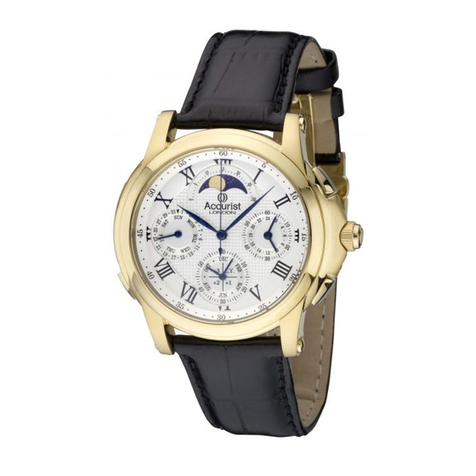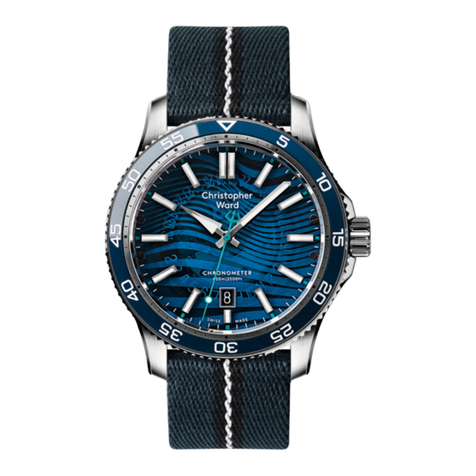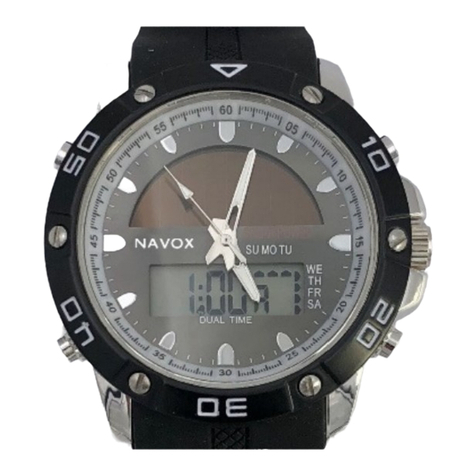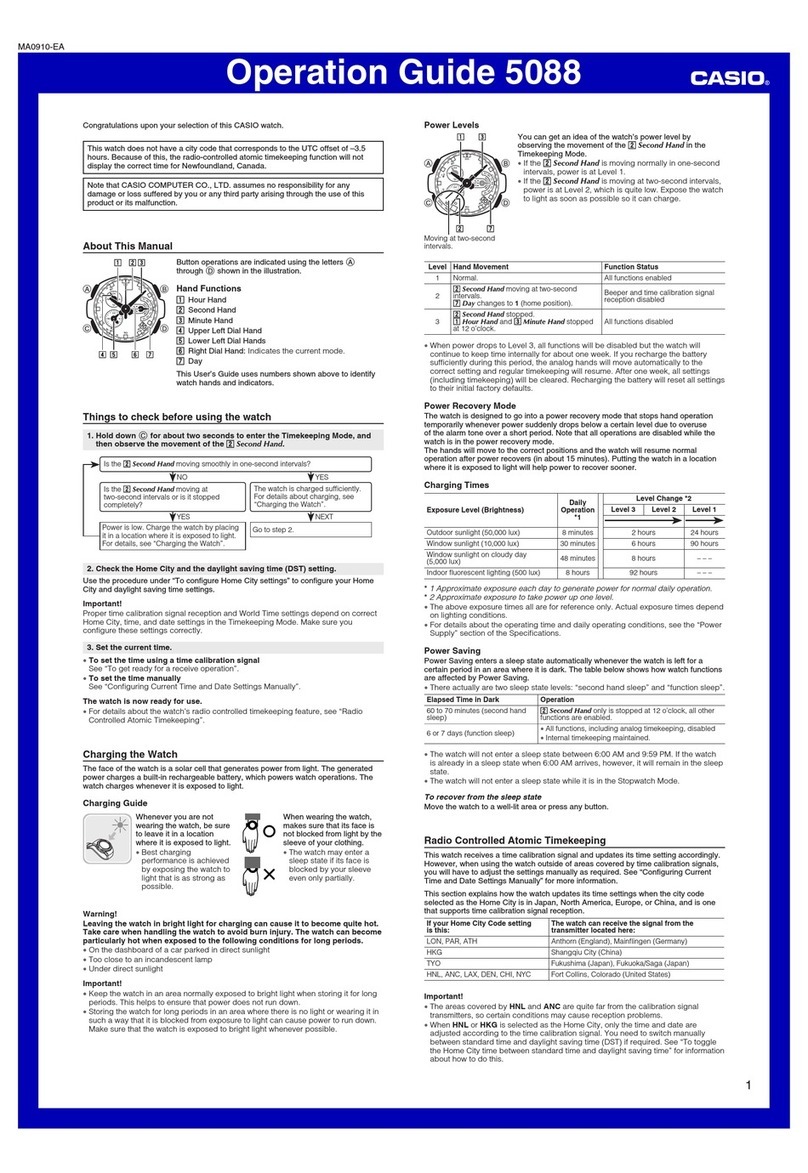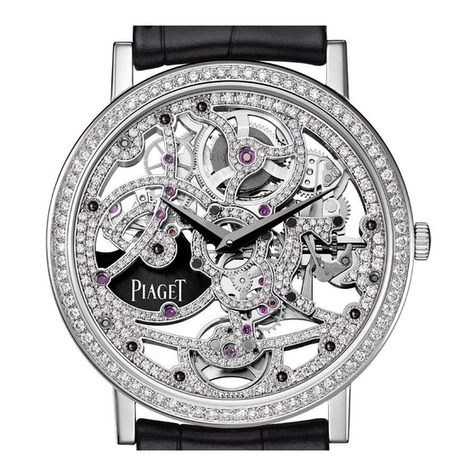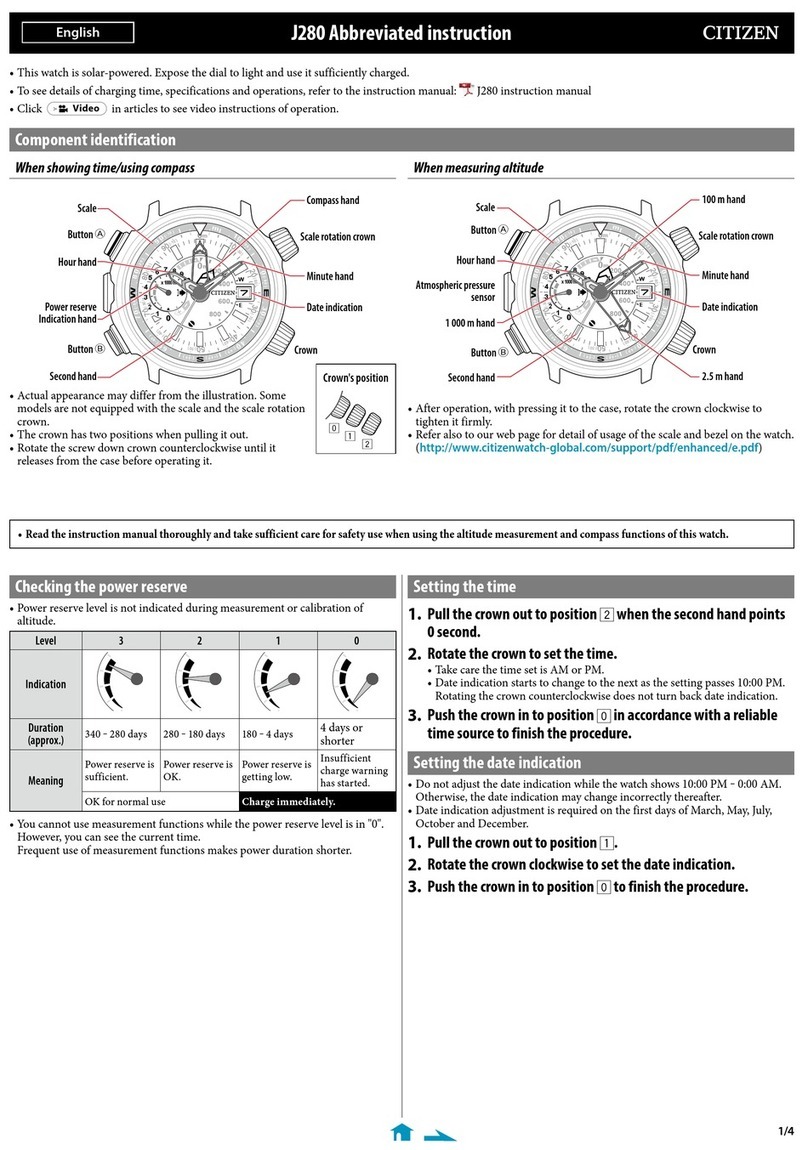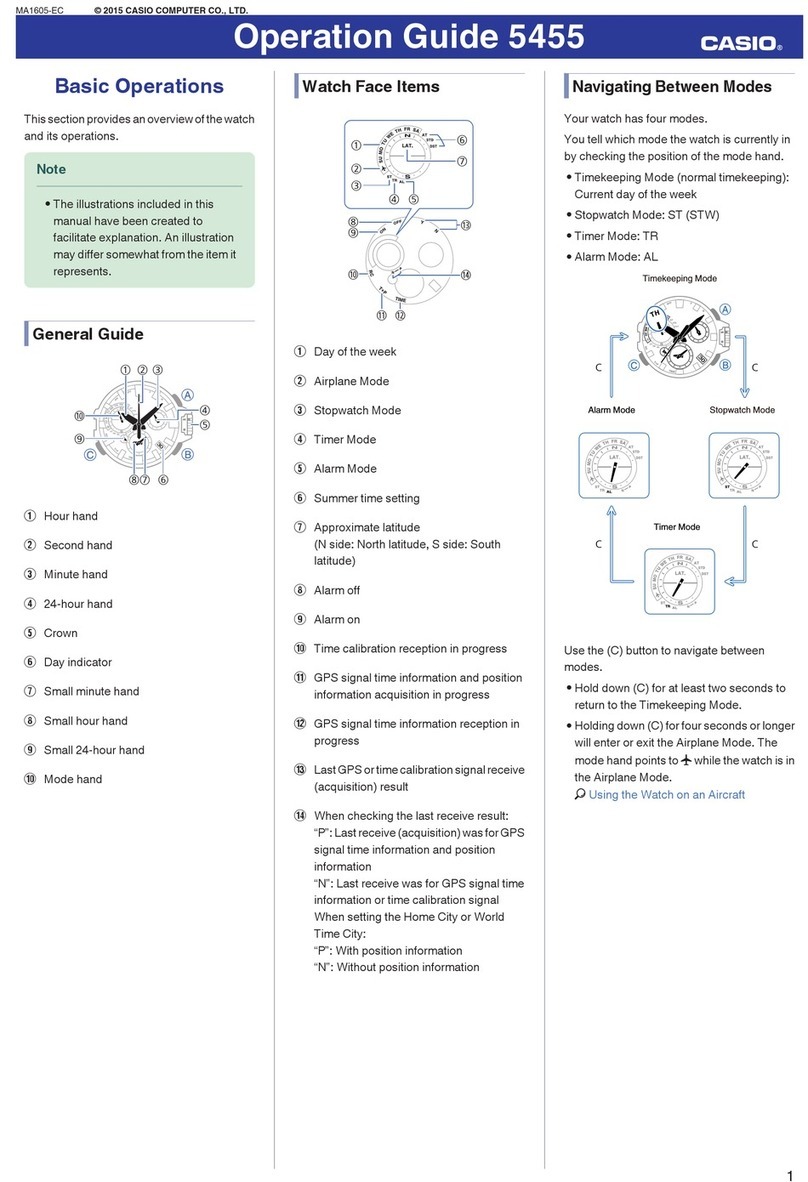The Greenwich Masters CELESTIAL User manual

CELESTIAL WATCH
INSTRUCTION MANUAL


Contents
1. Specifications ..................................................................................3
2. Celestial Watch ................................................................................4
3. Constellation Display of Entire Sky at 50°(or 35°) North Latitude...5
4. Features ...........................................................................................6
5. Setting the Time and Constellation Dial ........................................8
6. Times for Sunrise and Sunset ......................................................10
7. Concerning Constellation Dial Display .........................................11
8. Abbreviations of Constellations and their full spellings ................12
9. Nebulae and Star Clusters on the Constellation dial.......................16
10. Diagram of the Constellation Dial ...............................................18
11. Precautionary Items and Usage Limitations ................................20
12. Warranty and Service ...................................................................29

3.
1. Specifications
1. Calibre No: 4P92
2. Frequency of crystal oscillator: 32.768 Hz (Hz: frequency per second).
3. Accuracy: Within +/- 20 seconds per month
(when worn at normal temperature +5°C - + 35°C)
4. Operating temperature range: -10°C - +60°C
5. Additional Functions:
• Constellation display functions
(period of constellation dial rotation: approx 23 hours 56 minutes and 4 seconds)
• Planisphere dial function
• Displaying of solar position
• Displaying of altitude and azimuth
• Displaying of local sidereal time
• Twilight identification function
• Displaying of pole star angle
6. Battery: Silver oxide battery 1 pce. 280-39(SR626SW)
7. Battery life: Approximately 3 years (after installing a new battery).
Specifications are subject to change without notice.

2. Celestial Watch
The Celestial Watch is a precisely designed analog quartz watch that
displays not only the current time but also the correct positions of the
constellations as they move across the sky. The Celestial Watch shows
azimuth (bearing) and altitude (angular position above the horizon) of the
major fixed stars, nebulae, galaxies and star clusters, displays local sidereal
(star) time, stellar spectral type. The Celestial Watch also has features that
provide such convenient information as the position of the sun, the time of
sunrise and sunset, and thus the hours of darkness when astronomical
observations may be made.
4.

3. Constellation Display of Entire Sky at 50°or 35°North
Because distortion is minimal in the northern hemisphere, approximately
98.5% of the celestial sphere visible at 50°or 35°north latitude is displayed.
(The range shown on the constellation dials from -40°to +90°
declination).
The design varies from one model to another.
5.
Right ascension scale
Date scale
Zenith
Horizon
Ecliptic Celestial equator
-18 altitude (twilight zone)
Constellation dial setting
Meridian
Crown
Normal position
Time setting
Direction for turning
constellation dial

4. Features
The Constellation display includes the positions of 1056 fixed stars with a
brightness of the 4.8th magnitude or brighter, 169 major nebulae,galaxies
and star clusters, constellation boundaries and the ecliptic and the celestial
equator based on their positions for the year 2000.0. (Maximum magnitude
values are indicated for variable stars. Fixed stars are represented by a four
colour spectrum at 0.1 magnitude intervals).
The constellation dial not only automatically displays the present positions
of constellations but can also be used as a planisphere dial in which the
constellations dial is independently rotated.
The solar position display shows the position of the sun along the ecliptic
(the sun’s apparent path on the celestial sphere during the year) on the 1st,
11th and 21st of each month (for 12 noon universal time over the mean
year). Times for sunrise and sunset as well as the number of daylight hours
are determined by looking on the horizon line on the transparent dial.
The altazimuth display lets you determine the altitude and azimuth of the
sun as well as the major fixed stars, nebulae, galaxies and star clusters on
the celestial sphere. (The equidistant almucanter lines at intervals of 15°on
the transparent dial are corrected for atmospheric aberration.
6.

4. Features continued...
The local sidereal time display lets you easily determine the location of the
constellations. (Local sidereal time can be read off the right ascension
graduation on the constellation dial opposite the correct date on the date
scale).
The twilight indicator lets you identify the hours of increasing darkness,
especially convenient for astronomical observations. (Astronomical
twilight line: use the -18°altitude on the transparent dial to determine the
beginning and ending times for the hours of astronomical twilight).
The pole star hour angle display lets you align an astronomical telescope to
the polar axis. (Right ascension values for the pole star between the years
2000.0 - 2050.0 are marked on the constellation dial for every ten years).
Hour angle is the angle measured counterclockwise from the meridian on
the transparent dial to the point marking the value for the right ascension
the present pole star.
The celestial sphere at the centre of the rotating constellation dial is not
displayed owing to the attachment of the watch hands.
7.

5. Setting the Time and Constellation Dial
Setting the time
1) When the second hand indicates 0 seconds, pull the crown out to the
second position.
2) Turn the crown and set the hour and minute hands to the correct time.
Move the minute hand 4 to 5 minutes ahead of the correct position and then
return it to the correct position.
3) Properly push the crown into its normal position in accordance with a
standard time signal or the like.
Setting the constellation dial
1) First it is necessary to find the correct sidereal time for the local standard
meridian or the universal time meridian.
2) Check the time difference in sidereal time between observation point
longitude and the standard meridian for the sidereal time source. Local
sidereal time depends on longitude, and is advanced four minutes per degree
eastward.
3) Pull the crown out to the first position.
4) Calculate the time obtained by adding the present sidereal time (displayed
on the 24 hour time scale) to the sum of the difference between local sidereal
time and present time. Find the value corresponding to this time on the right
ascension scale, and align it with the date scale turning the constellation
dial clockwise. 8.

5. Setting the Time and Constellation Dial continued...
Example: To align the
constellation dial for 12.00 June
11 at a position 5°west of the
standard time longitude, turn the
constellation dial clockwise until
the point on the dials right
ascension scale opposite 11.40 is
in line with the point on the date
scale corresponding to June 11.
7) Push the crown into its normal position.
Increments on the date scale are calibrated for 12 noon Universal Time
(21h Japanese Standard Time) over the mean year. Wide lines of the date
scale are indicated for the 1st. 11th and 21st of each month. Narrow lines
of the date scale are indicated for the 6th, 16th and 26th of each month.
9.
June 11
11.40

6. Times for Sunrise and Sunset
Example: Sunrise time for March 11 at the standard time longitude.
1) Pull the crown out to
the first position.
2) Turn the crown and
bring the solar position
for March 11 on the
ecliptic on the
constellation dial so that
it overlaps the transparent
dials outline of the east
horizon.
3) The mean solar time of
sunrise will be shown as
the constellation dials
right ascension scale
corresponding to the date
for March 11. In areas where summertime is in force add one hour to the
time indicated. After checking this function, turn the crown and return the
constellation dial clockwise to its present
position. Push the crown into its normal position. 10.
March 11
March 11
6:23

7. Concerning the Constellation Dial Display
The fixed stars are generally classified into the following four spectral
types according to their spectra.
Bluish silver ........Spectrum O or B type stars 274 stars
Silver ...................Spectrum A or F type stars 354 stars
Yellowish silver....Spectrum G or K type stars 353 stars
Orangish silver.....Spectrum G or K type stars 75 stars
Stellar magnitudes are displayed near the right ascension graduations of Oh
on the constellation dial.
Hard to differentiate neighbouring stars (including multiple stars) are
indicated in terms of synthetic brightness, with the colour being that of the
spectral class for the main (brightest in appearance) star in the binary stars.
Variable stars are not distinguished from other fixed stars.
The major nebulae, galaxies and star clusters are displayed in light green
on the constellation dial.
The star clusters of Pleiades and Hyades are shown together.
11.

8. Abbreviations of Constellations and their full spellings
Abbreviations
And
Ant
Aps
Aql
Aqr
Ara
Ari
Aur
Boo
Cae
Cam
Cap
Full Spellings
Andromeda
Antlia
Apus
Aquila
Aquarius
Ara
Aries
Auriga
Bootes
Caelum
Camelopardalis
Caprico
Abbreviations
Car
Cas
Cen
Cep
Cet
Cha
Cir
CMa
CMi
Cnc
Col
Com
Full Spellings
Carina
Cassiopeia
Centaurus
Cepheus
Cetus
Chamaeleon
Circinus
Canis Major
Canis Minor
Cancer
Columba
Coma Berenices
12.

8. Abbreviations of Constellations and their full spellings continued...
Abbreviations
CrA
CrB
Crt
Cru
Crv
CVn
Cyg
Del
Dor
Dra
Equ
Eri
Full Spellings
Coruna Australis
Coruna Borealis
Crater
Crux
Corvus
Canes Venatici
Cygnus
Delphinus
Dorado
Draco
Equuleus
Eridanus
Abbreviations
For
Gem
Gru
Her
Hor
Hya
Hyi
Ind
Lac
Leo
Lep
Lib
Full Spellings
Fornax
Gemini
Grus
Hercules
Horologium
Hydra
Hydrus
Indus
Lacerta
Leo
Lepus
Libra
13.

8. Abbreviations of Constellations and their full spellings continued...
Abbreviations
LMi
Lup
Lyn
Lyr
Men
Mic
Mon
Mus
Nor
Oct
Oph
Ori
Full Spellings
Leo Minor
Lupus
Lynx
Lyra
Mensa
Microscopium
Monoceros
Musca
Norma
Octans
Ophiuchus
Orion
Abbreviations
Pav
Peg
Per
Phe
Pic
PsA
Psc
Pup
Pyx
Ret
Scl
Sco
Full Spellings
Pavo
Pegasus
Perseus
Phoenix
Pictor
Piscis Austrinus
Pisces
Puppis
Pyxis
Reticulum
Sculptor
Scorpius

8. Abbreviations of Constellations and their full spellings continued...
Abbreviations
Sct
Ser
Ser
Ser
Sex
Sge
Sgr
Tau
Tel
Full Spellings
Scutum
Serpens
Serpens Caput
Serpens Cauda
Sextans
Sagitta
Sagittarius
Taurus
Telescopium
Abbreviations
TrA
Tri
Tuc
UMa
UMi
Vel
Vir
Vo l
Vul
Full Spellings
Triangulum Australe
Triangulum
Tucana
Ursa Major
Ursa Mino
Vela
Virgo
Volans
Vulpecularnus
15.
Abbreviations are not shown for the constellations Aps, Cha, Cir, Cru, Hyi,
Men, Mus, Oct, Pav, TrA, Tue and Vol since they are included in the entire
or nearly entire range of the celestial sphere unable to be viewed from 35°
north latitude.

9. Nebulae, Galaxies and Star Clusters on the Constellation Dial in Light Green
M31(And) NGC752(And) M72(Aqr) NGC7009(Aqr) NGC7293(Aqr)
NGC6167(Ara) 1.4651(Ara) NGC6397(Ara) M38(Aur) M36(Aur)
M37 (Aur) NGC2403(Cam) M30(Cap) NGC281(Cas) NGC457(Cas)
NGC559(Cas) M103(Cas) 1.1805(Cas) 1.1848(Cas) NGC7635(Cas)
M52(Cas) NGC7789(Cas) NGC4945(Cen) NGC5128(Cen) NGC5139(Cen)
NGC5460(Cen) NGC6946(Cep) NGC247(Cet) NGC246(Cet) M77(Cet)
M41(CMa) M44(Cnc) M67(Cnc) NGC1851(Col) M98(Com) M99(Com)
M100(Com) M85(Com) M88(Com) NGC4548(Com) NGC4565(Com)
M64(Com) M53(Com) NGC6541(CrA) NGC4258(CVn) NGC4449(CVn)
NGC4631(CVn) M94(CVn) M63(CVn) M51(CVn) M3(CVn)
NGC6871(Cyg) 1.1318(Cyg) M29(Cyg) NGC6992-5(Cyg) NGC7000(Cyg)
M39(Cyg) NGC5866(Dra) NGC1291(Eri) NGC1316(For) M35(Gem)
NGC2392(Gem) M13(Her) M92(Her) M48(Hya) NGC3242(Hya)
M68(Hya) M83(Hya) NGC2903(Leo) M95(Leo) M96(Leo) NGC3379(Leo)
NGC3521(Leo) M65(Leo) M66(Leo) M79(Lep) NGC5897(Lib)
NGC5822(Lup) NGC5986(Lup) M57(Lyr) M56(Lyr) NGC2237-9(Mon)
NGC2301(Mon) M50(Mon) NGC6067(Nor) NGC6171(Oph) M12(Oph)
M10(Oph) M62(Oph) M19(Oph) M9(Oph) M14(Oph) NGC6633(Oph)
16.

9. Nebulae, Galaxies and Star Clusters on the Constellation Dial in Light Green
continued ...
M42(Ori) M78(Ori) NGC2174-5(Ori) M15(Peg) M76(Per) NGC869(Per)
NGC884(Per) M34(Per) NGC1245(Per) NGC1499(Per) NGC1528(Per)
M74(Psc) M47(Pup) M46(Pup) M93(Pup) NGC2546(Pup) NGC55(Scl)
NGC253(Scl) NGC300(Scl) M80(Sco) M4(Sco) NGC6124(Sco) H12(Sco)
M6(Sco) M7(Sco) M26(Sct) M11(Sct) M5(Ser) M16(Ser) 1.4756(Ser)
M71(Sge) M23(Sgr) M20(Sgr) M8(Sgr) M21(Sgr) M24(Sgr) M18(Sgr)
M17(Sgr) M28(Sgr) M69(Sgr) M25(Sgr) M22(Sgr) M70(Sgr) M54(Sgr)
NGC1746(Tau) M1(Tau) M33(Tri) M81(UMa) M82(UMa)
NGC3556(Uma)M97(Uma) M101(UMa) NGC2547(Vel) 1.2395(Vel)
H3(Vel) NGC3132(Vel) NGC3201(Vel) M61(Vir) M84(Vir) M49(Vir)
M87(Vir)M89(Vir) M90(Vir) M58(Vir) M104(Vir) M59(Vir) M60(Vir)
M27(Vul)NGC6940(Vul)
Nebulae and star clusters are arranged in alphabetical order of the
constellations to which they belong and in the order of right ascention within
a particular constellation (moving to the right around the constellation dial).
17.

10. Diagram of the Constellation Dial
1) Sirius (Cma)
2) Canupus (Car)
3) Arcturus (Boo)
4) Vega (Lyr)
5) Capella (Aur)
6) Rigel (Ori)
7) Procyon (CMi)
8) Betelgeuse (Ori)
18.

19.
10. Diagram of the Constellation Dial continued...
9) Altair (Aql)
10) Aldebaran (Tau)
11) Antares (Sco)
12) Spica (Vir)
13) Stellar magnitudes
14) Milky Way
15) Solar Position (Oct 21)
16) Right ascension of the
pole star (2000.0)
Table of contents
Other The Greenwich Masters Watch manuals
Popular Watch manuals by other brands
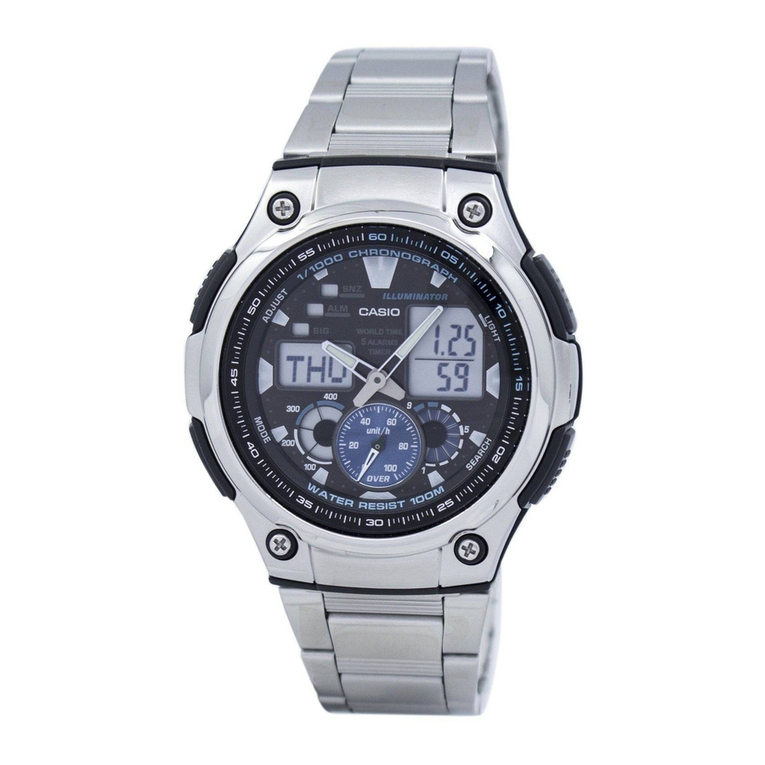
Casio
Casio AQ190WD-1A Operation guide

Casio
Casio G-Shock AW591-2A Operation guide

HighGear
HighGear Alti-XT Series Quick start manual
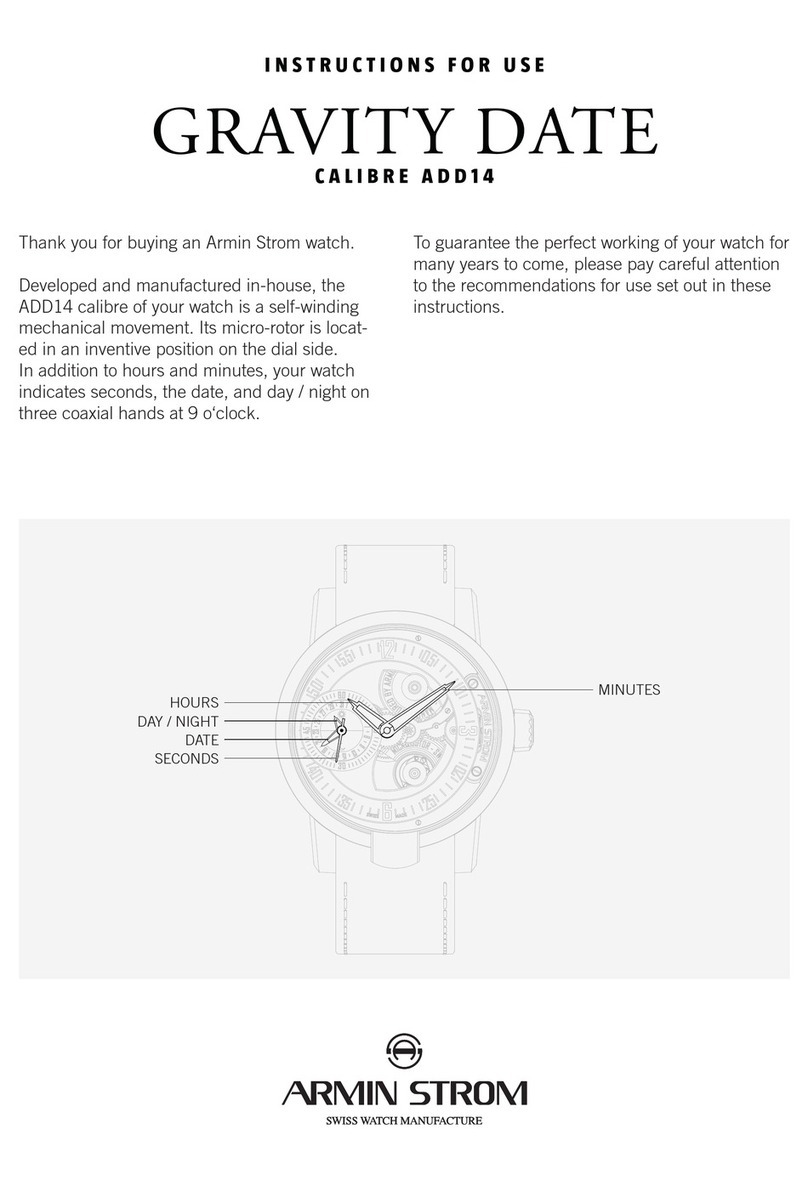
Armin Strom
Armin Strom GRAVITY DATE ADD14 Instructions for use
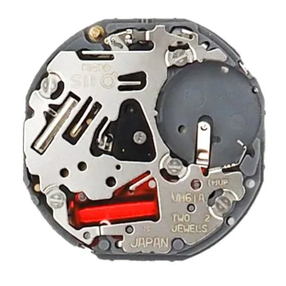
TMI Products
TMI Products VD56B Technical guide & parts catalogue
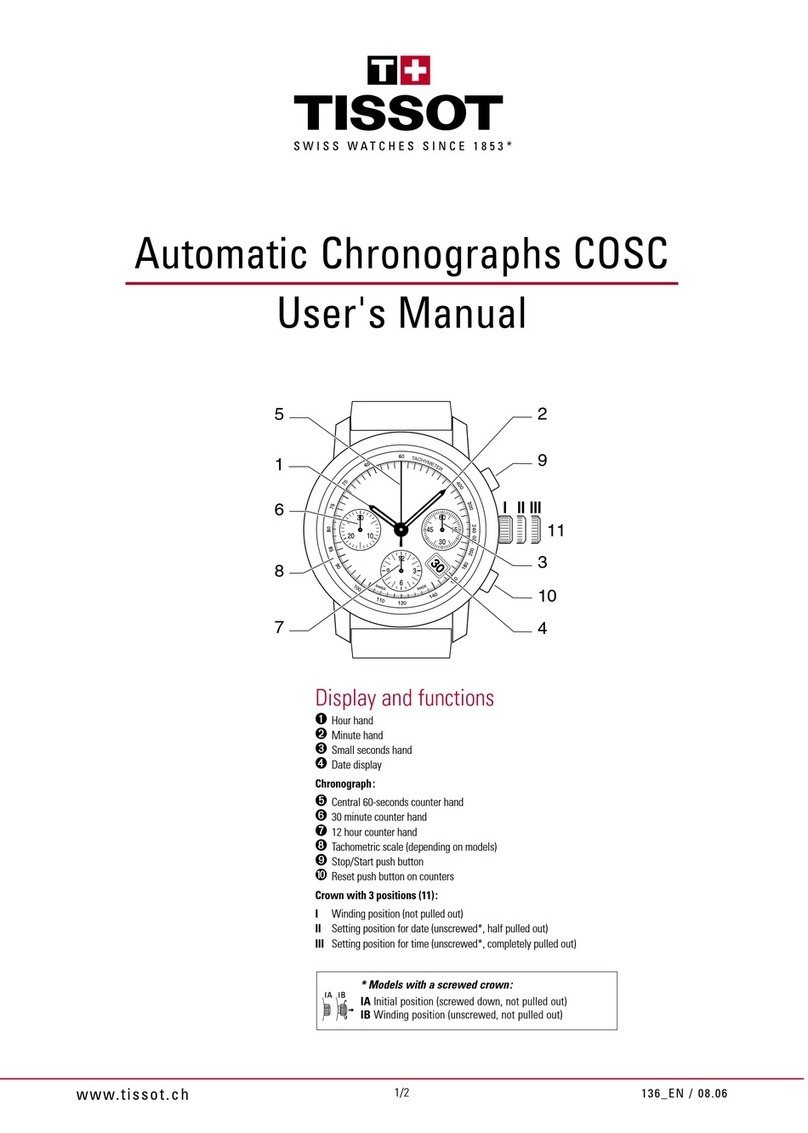
Tissot
Tissot AUTOMATIC CHRONOGRAPHS COSC user manual
